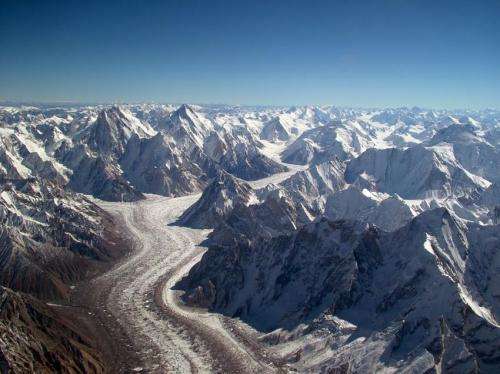October 13, 2014 report
Simulation explains why Asian glaciers are not melting

A team of researchers in the U.S. has built a model that appears to explain the Karakoram anomaly—where unlike other parts of the world, its mountainous glaciers are not melting. In their paper published in the journal Nature Geoscience, the team explains the factors that went into their model and why their simulation appears to explain the real world phenomenon.
As most everyone knows by now, the planet is warming, and because of that, glaciers across the globe are melting, with many expected to disappear over the next century, or sooner. One exception, however, is the Karakoram, a mountain chain that runs along the borders of China, India, and Pakistan—it's technically part of the Himalaya chain. There, scientists have discovered that not only are the glaciers not melting, they appear to be growing, continually defying predictions.
To find out why glaciers in that part of the world are thriving despite a rise in global temperatures, the researchers gathered weather data dating back to 1861 on three major parts of the Himalaya chain—the southeast portion, the central portion and the Karakoram. The amount of data allowed them to create a much finer map of the area than prior efforts—down to an area of just 19 square miles.
After imputing the data and running the simulations—representing weather patterns right up to 2100—the researchers found that the central and southeast part of the chain received most of its moisture from the annual monsoons. The Karakoram, in contrast, got most of its precipitation in the winter, which of course meant more snow. The team notes that their model shows that the total amount of precipitation along most of the chain is increasing as the planet heats up, during the summer months. In the Karakoram, on the other hand, there is less snowfall in the summer, but more in the winter—thus the continued growing of the glaciers. Their model suggests that the glaciers are likely to continue to persist in that part of the world, right on up to 2100—after that, it doesn't appear likely—not if global warming continues at its current pace.
More information: Nature Geoscience (2014) DOI: 10.1038/ngeo2269
Journal information: Nature Geoscience
© 2014 Phys.org


















